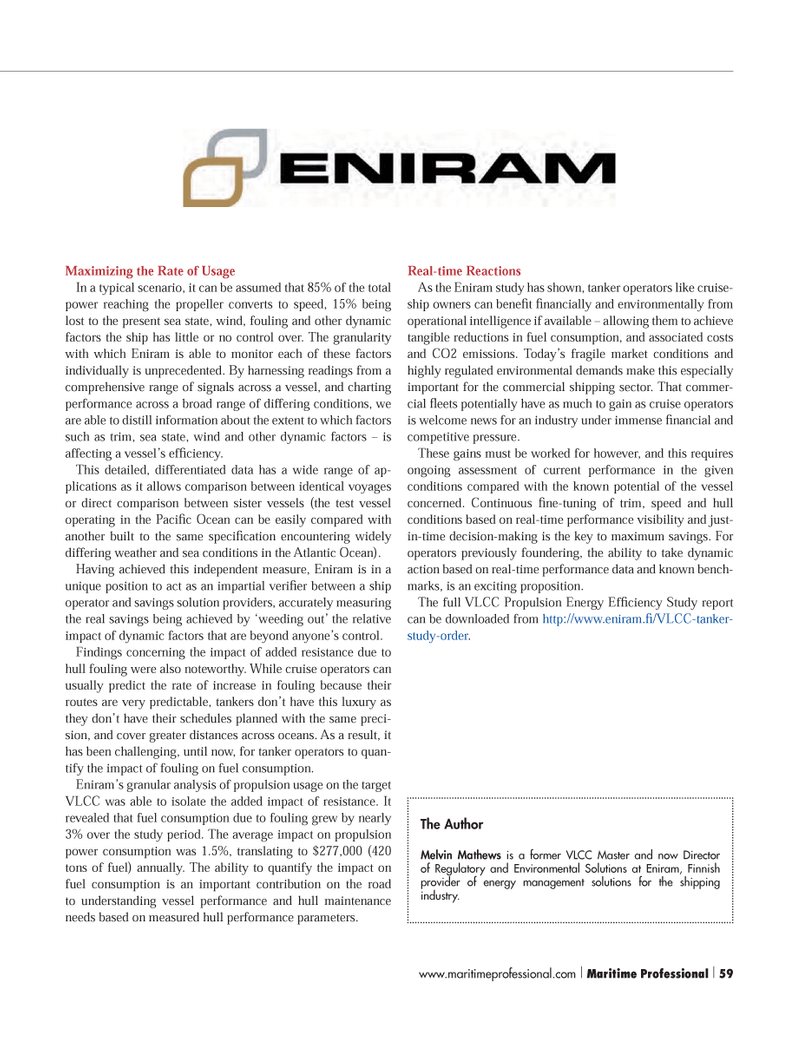
Page 59: of Maritime Logistics Professional Magazine (Q3 2012)
Classification Societies, Quality & Design
Read this page in Pdf, Flash or Html5 edition of Q3 2012 Maritime Logistics Professional Magazine
Maximizing the Rate of UsageIn a typical scenario, it can be assumed that 85% of the total power reaching the propeller converts to speed, 15% being lost to the present sea state, wind, fouling and other dynamic factors the ship has little or no control over. The granularity with which Eniram is able to monitor each of these factors individually is unprecedented. By harnessing readings from a comprehensive range of signals across a vessel, and charting performance across a broad range of differing conditions, we are able to distill information about the extent to which factors such as trim, sea state, wind and other dynamic factors ? is affecting a vessel?s ef ciency. This detailed, differentiated data has a wide range of ap- plications as it allows comparison between identical voyages or direct comparison between sister vessels (the test vessel operating in the Paci c Ocean can be easily compared with another built to the same speci cation encountering widely differing weather and sea conditions in the Atlantic Ocean). Having achieved this independent measure, Eniram is in a unique position to act as an impartial veri er between a ship operator and savings solution providers, accurately measuring the real savings being achieved by ?weeding out? the relative impact of dynamic factors that are beyond anyone?s control. Findings concerning the impact of added resistance due to hull fouling were also noteworthy. While cruise operators can usually predict the rate of increase in fouling because their routes are very predictable, tankers don?t have this luxury as they don?t have their schedules planned with the same preci- sion, and cover greater distances across oceans. As a result, it has been challenging, until now, for tanker operators to quan- tify the impact of fouling on fuel consumption.Eniram?s granular analysis of propulsion usage on the target VLCC was able to isolate the added impact of resistance. It revealed that fuel consumption due to fouling grew by nearly 3% over the study period. The average impact on propulsion power consumption was 1.5%, translating to $277,000 (420 tons of fuel) annually. The ability to quantify the impact on fuel consumption is an important contribution on the road to understanding vessel performance and hull maintenance needs based on measured hull performance parameters.Real-time ReactionsAs the Eniram study has shown, tanker operators like cruise- ship owners can bene t nancially and environmentally from operational intelligence if available ? allowing them to achieve tangible reductions in fuel consumption, and associated costs and CO2 emissions. Today?s fragile market conditions and highly regulated environmental demands make this especially important for the commercial shipping sector. That commer- cial eets potentially have as much to gain as cruise operators is welcome news for an industry under immense nancial and competitive pressure. These gains must be worked for however, and this requires ongoing assessment of current performance in the given conditions compared with the known potential of the vessel concerned. Continuous ne-tuning of trim, speed and hull conditions based on real-time performance visibility and just-in-time decision-making is the key to maximum savings. For operators previously foundering, the ability to take dynamic action based on real-time performance data and known bench- marks, is an exciting proposition. The full VLCC Propulsion Energy Ef ciency Study report can be downloaded from http://www.eniram. /VLCC-tanker- study-order.The Author Melvin Mathews is a former VLCC Master and now Director of Regulatory and Environmental Solutions at Eniram, Finnish provider of energy management solutions for the shipping industry. www.maritimeprofessional.com | Maritime Professional | 59

 58
58

 60
60
